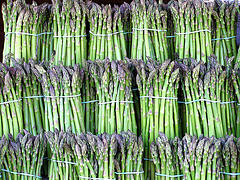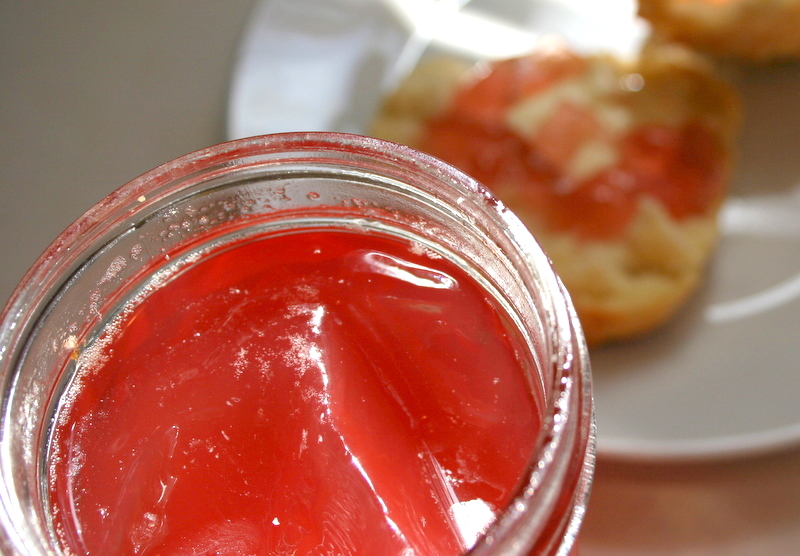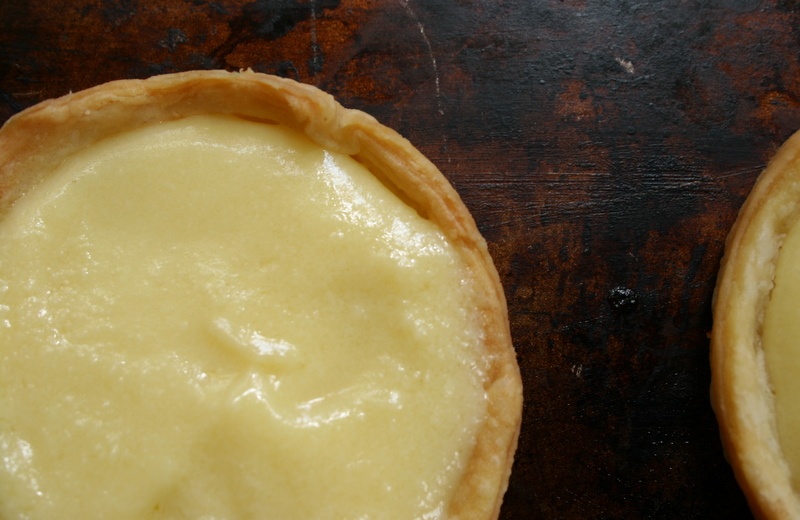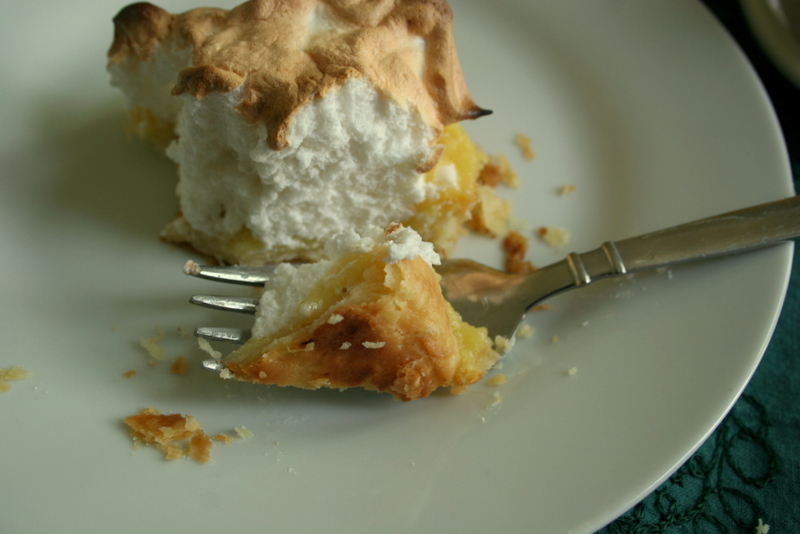We often buy lettuce as full heads, yet when growing lettuce we can harvest it a few different ways by removing the whole head, taking just the outer leaves, cutting the head down to an inch off the ground and watching it regrow another head, or growing lettuce as baby leaf micro-greens for harvest all summer long. Baby leaf harvests are ready in as little as 21 days. I sow succession plantings of lettuce about every three weeks outside in the gardens during warm months, inside in pots throughout the winter, and eat homegrown lettuce all year long.
Pickled Spring
It seems like most of North America is a lot closer to summer, while the Avalon is still in early spring mode. That being said, there's a big advantage to this: spring crops can get a second (or third) round before the heat starts. As well, while we may not have had a lot of sun, we've had plenty of rain, which is great for some plants. The question then becomes, what do we do with all the extra? I have one word for you: PICKLING.
A lot of people associate pickling with the fall; beets, cucumbers, late-crop beans and the like. Personally, I think that a lot of spring veggies get even better with a good dose of brine! So, with that, here are a few recipes to capture spring in a bottle of herbs, vinegar and salt.
Asparagus is reaching the end of its season in Eastern parts of Canada, but if you can find some fresh stuff, Pickled Asparagus is a real treat. This recipe, courtesy of WellPreserved.ca (a blog run by a fantastic couple in Toronto) would also work for my favourite pickle in the world, Pickled Garlic Scapes.
Speaking of Pickled Garlic Scapes, Washington's Green Grocer has a very interesting spin on them, including flowers in the final product!
Just about everyone I know has access to at least one rhubrarb plant, which isn't surprising since it grows like a weed! I love the tart flavour of rhubarb, so I'm very curious to try giving it a dose of brine!
And finally, need to clear out some of those turnip greens before they go bad? Why not give try this Pickled Mustard Greens recipe a try? The basic principle would be the same, and you'd have a really interesting side dish for spicy stir fries or BBQ skewers.
Cheese and eggs and greens, oh my!
 Now is the time, my friends, when giant, balloon-sized bags of local greens appear in the grocery shops. I love them so much! They arrive in late spring, and they are just beautiful steamed and dripping with butter on the side of your plate.
These greens are often labeled "fresh greens," or "field greens," but many people call them "turnip greens" or "turnip tops." They're inexpensive, and they're wonderfully nutritious. The only flaw with them is that the bags they come in are enormous, and the greens are tender enough that they don't last very long in the fridge, so you have to use them up quickly.
Now is the time, my friends, when giant, balloon-sized bags of local greens appear in the grocery shops. I love them so much! They arrive in late spring, and they are just beautiful steamed and dripping with butter on the side of your plate.
These greens are often labeled "fresh greens," or "field greens," but many people call them "turnip greens" or "turnip tops." They're inexpensive, and they're wonderfully nutritious. The only flaw with them is that the bags they come in are enormous, and the greens are tender enough that they don't last very long in the fridge, so you have to use them up quickly.
One recipe I came up with a few years ago to cope with the massive amounts of leafy greens is my turnip top pesto. I enjoy this stuff so much that I've written about it twice, first in The Scope, and then on my old blog. It's a very easy way to use up a few big handfuls of greens, and it's delicious on pasta, on pizza, in melts, and in risotto. It also freezes brilliantly; I pack it in half-cup canning jars and stash it in the deep freeze to pull out over the winter for a nice taste of spring.
This year, I thought I should come up with some new ways to incorporate the greens into my family's dinners. First I made a quiche. I had three motivations for this. I had just bought a gorgeous quiche pan at a garage sale for a dollar and I was desperate to use it, I had leftover ham in the fridge, and I wanted to taste-test some of the new locally-produced Central Dairies cheese. Quiche is dead easy to make, and it's a great way to eat local: eggs are one local food product that you can pretty much always get your hands on.
If quiche isn't part of your cooking repertoire, here are a couple good videos that can help you through the process. One is a quick and dirty intro to quiche-making, and the other is a leisurely, meditative approach to quiche. Quiche is more of a method than a recipe; you can use any vegetables or bits of cheese or leftover meats (generally bacon, ham, or sausage), you can use a shop-bought crust or a homemade one (or go crustless if you prefer), you can eat it hot or at room temperature, and it pretty much always works out beautifully. Mine was fantastic! I steamed the greens first, and used Central Dairies peppercorn edam (my new favourite) to complement the greens and the ham.
The next day, I decided to make something similar to a Greek spanakopita. If you've never had spanakopita, it's a delicious savoury pie, generally made with spinach, feta cheese, and eggs, and wrapped in flaky, golden phyllo. There are many different recipes available online and in cookbooks, and there is a great video here. I used Central Dairies feta, which is quite different from the feta I'm used to: it is firm, rather than crumbly. The taste is great, but in order to get the texture I wanted I had to stir in some ricotta. I steamed my greens to wilt them, and used chives from my garden, and green onions and basil from my windowsill. Traditional recipes usually call for dill, but I didn't have any on hand. Even without the dill, it was delicious. Oh, and I most certainly did not make my own phyllo pastry! Storebought phyllo (sometimes spelled "filo") is just fine, and you can get it in the freezer at most supermarkets.
Spanakopita freezes very well. You can prepare it up to the point when you would normally put it in the oven, then wrap it tightly and put it in the freezer. This is another great way to preserve your greens for the months ahead. Make sure you thaw your spanakopita (or "turnip-topita," as I have been calling this, with total disregard for linguistic accuracy) completely before putting it in the oven, and keep it covered while thawing, or else the phyllo will dry out. Brush it with a bit of olive oil before you bake it, and there you go: yumness.
Do you have a favourite way to prepare and eat turnip greens? Is there anything new you plan to try with them this year?
What weed? Knotweed!
When Costa wrote his defense of Japanese knotweed last month, I was very excited. So excited that I almost immediately ran to the lot at the top of my street with a paring knife and filled a paper bag with bright, tender knotweed shoots. I turned them into a tasty soup and was most impressed with myself. The next week, I tried serving plain steamed knotweed spears as a side dish. This time, I am afraid to say, I was not so pleased. Steamed, the knotweed took on this pallid olive-green tone, and deflated into a mass of floppy, stringy mush before my very eyes. Not to my taste, not one bit.
The knotweed has been redeemed, though. Earlier this week I made knotweed jelly, following this recipe, which you may have already seen: it's one of the first things that comes up when you search "Japanese knotweed recipes." I followed the recipe exactly, except that I decided to half it, just in case it turned out to be horrible. It didn't, though. It's lovely!
It's surprisingly mellow in flavour, and almost floral. I ate it on scones, but I think it would be nice swirled into a cheesecake or used to fill thumbprint cookies. You could also keep it on hand to use as a glaze for sweet baked goods and fruit-filled tarts: just melt a little in a pot over low heat and spoon or brush it over the surface of your baked, cooled tasties. (If you haven't done any canning before, read the instructions on the Bernardin site: they're excellent.)
Since I only used part of the knotweed juice from the jelly recipe, I had enough to spare to make some knotweed curd. It was one of those "why not?" situations. I love lemon curd, and I love rhubarb curd, so why not try knotweed curd? I adapted Nigella Lawson's lime curd recipe to come up with this:
Japanese knotweed curd
(makes about 350 mL)
- 5 tablespoons unsalted butter
- 1/3 cup sugar
- 1/2 cup knotweed juice
- 1 tablespoon lemon juice
- 2 extra-large eggs, plus one egg yolk, beaten
In a medium saucepan, melt butter over low heat. Add all other ingredients and whisk to combine. Continue to heat, stirring constantly, until mixture thickens up. If you want to check if it's thick enough, lift out your spoon and run your finger through it: if it looks thick enough, it is! Pour the curd through a sieve into a clean jar. Cover and cool. Will keep in the fridge for a week or so.
The yellow of the happy egg yolks (from the Goulds, via Halliday's) overtook the pink of the knotweed juice, and the flavour is quite subtle, but it is tasty and custardy. Of course, having a jar of curd in the house, and a leftover egg white, I had practically no choice but to make a few knotweed meringue tartlets. I was inspired by the orange curd tart on Rock Recipes (an awesome local recipe site), but I didn't want an entire tart in my house, as I would have eaten the whole thing (I cannot be trusted in the presence of meringue).
I wish I could give you a recipe, but, really, I was winging it. My usual pie crust recipe is here, and for the tarts I made about 1/3 of a batch. I pre-baked my three wee tart crusts in upside-down wide-mouth canning rings, because I don't have any mini tart rings. If you've never pre-baked a pie crust, there's a good explanation of the best way to do it here. If you make mini-tarts, you'll have to adjust the time: I had mine in the oven for about 7 minutes.
Once that was done, I filled the pastry shells with curd, like so:
Then I whipped the egg white with 1/8 teaspoon of cream of tartar until soft peaks began to form, then I added a little less than 1/4 cup of sugar and whipped a bit more. I overwhipped a little, actually, and had to smoosh the meringue on to the tarts with my fingers because it was too thick to spread. Ooops! I popped the tarts back into the oven at 400F for a couple minutes to brown, then let them cool.
Come mid-afternoon, I rewarded myself for my ingenuity with a knotweed meringue tart and a cappuccino. It was marvelous! Not tangy like a lemon tart, but the marshmallowy meringue provided a nice textural contrast to the dense, eggy curd. Really, you should give it a try! If my vague instructions are too loosey-goosey for you (and I don't blame you if they are), just make the curd and use a favourite lemon meringue pie recipe (or the Rock Recipes one above), filling the shell with knotweed curd instead of the usual filling.
Let me tell you, I'm definitely looking at those encroaching fields of knotweed in a new light. I'll be making another batch of knotweed jelly this week, and maybe some extra for holiday presents. I can almost guarantee nobody's going to say, "Oh, man, not another jar of homemade Japanese knotweed jelly!"
















